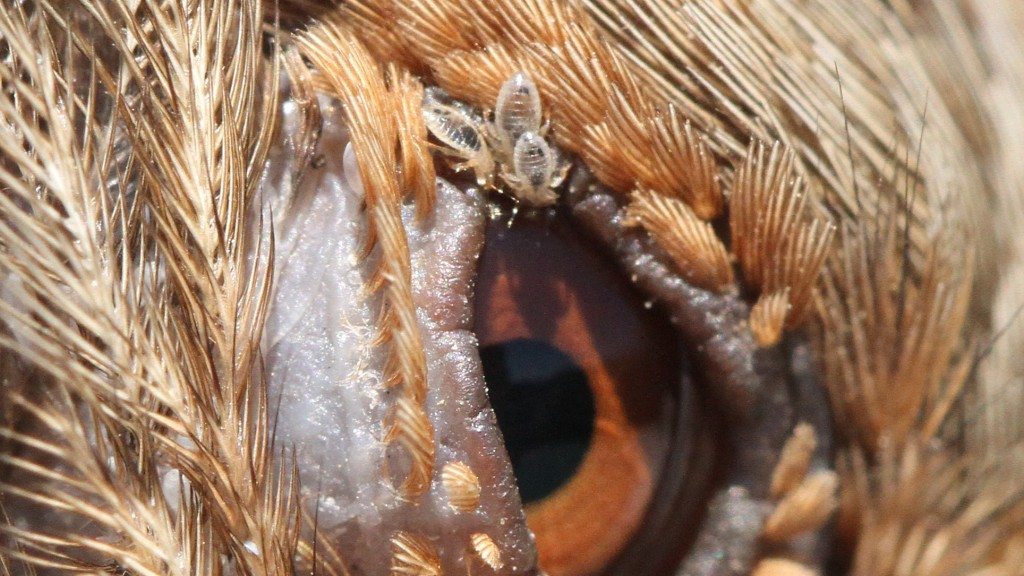Rescuing a bird – and its lice
By Dave Strauss
In early June while driving along Arlington Avenue in Kensington, I spotted a little brown bird awkwardly thrashing in the road. It couldn’t fly and certainly would have been run over on this very busy route through the Berkeley hills, so I stopped and picked it up.
It was a California Towhee that appeared unable to move its right leg and right wing. I took it to our nearby home, hoping it might recover on its own after some time in protective custody — safe from the cars, cats, hawks, and other threats to a helpless songbird on the ground.
Once home, I put the bird in an open top cardboard box on the deck just outside my office door. It was a beautiful day, and after 10 or 15 minutes of struggling, it appeared to relax in the warmth of the sun and protection of the box. Passing time seemed to be the remedy for this little towhee; I could see that the right wing and leg were starting to move a little.
It’s great to save a bird, but as a photographer, this situation presented a second unusual opportunity. I had a bird-in-the-hand, and getting in close with a macro lens was easy. I shot a few pictures and set the camera aside to see if our recovering bird was ready to depart. It was. With a little coaxing, it was out of the box and soon flew off into its familiar habitat of Wildcat Canyon.
That was a gratifying moment, but I quickly turned my attention to the photos. I uploaded them to my computer and took a look. In one photo I could see small, nearly-transparent “bugs” in the corner of the Towhee’s right eye. I’d never seen that before. I emailed the photo to David Herlocker, the terrific and encyclopedic Interpretive Naturalist for Marin County Parks, asking him “What’s this?” as I have on many other occasions.

He replied, “Bird lice.”
After showing this photo to several friends, responses were along the lines of “Yuk”, “Ewwww”, and “Gross”, but I knew what they really meant was, “That’s amazing. Please investigate further and report back in writing.”
So here’s a handy word you can drop into everyday conversations and spelling bees: Phthirapterologist.
These are biologists who study lice. Within a few mouse clicks, it was clear that Phthirapterologists constitute a vibrant worldwide academic community complete with societies, conferences, journals, heroes, and villains. I couldn’t find a local phthirapterologist in the directory of the U.C. Integrative Biology faculty, but I asked Dr. Peter Oboyski, the Senior Museum Scientist at the Essig Museum of Entomology at U.C. Berkeley, to see if he could give me a lead. He did.

I wrote to Professor Sarah Bush at the University of Utah, an expert in bird lice (among many other things) with an annoying and presumptuous list of questions. Dr. Bush responded quickly and very generously with answers to all my questions. She also sent along a couple of papers with more details.
Here’s some of what I learned, thanks to Dr. Bush:
The lice in the photo are adults in the family Menoponidae. So, they are Arthropods (Arthropoda) » Insects (Insecta) » Barklice, Booklice, and Parasitic Lice (Psocodea) » Phthiraptera (Parasitic Lice) » Mallophaga (Chewing Lice) » Amblycera » Menoponidae. For anyone interested in further taxonomic details, I have a paper provided by Dr. Bush which I’d be happy to forward.
These lice are “ectoparasites,” which means they spend their complete life cycle on the body of the host. They feed on blood, and can harm or kill the birds if the population of lice gets too big. Most individual birds have few lice, but a few have very large numbers of lice.
Fortunately, birds can defend themselves and control the louse population in a variety of ways. Oral grooming, preening, and scratching can remove lots of lice. There is also evidence that mate selection is an important factor. To put it bluntly, a smart bird chooses a mate without lice – which seems like an excellent policy for any species. Some birds even “fumigate” their nests with green vegetation.
Dr. Bush said that no lice were previously known from the California Towhee, so this observation is considered a “new host record.” However, before I got too far celebrating my role in discovering a species new to science, I saw that Dr. Bush also said that it’s quite common to find lice where they haven’t been found before. There are probably thousands of species that haven’t yet been discovered and described. So these in the photo might represent a new species, or perhaps more likely be a species that has been observed and described only in other birds. Without specimens (which I don’t have) there’s no way to know.
Most of the lice in this family can only live on the host species. They will quickly die if the host dies, and they generally will not succeed on an alternate host of a different species (e.g., you and me).
In a photo I took a few minutes after the “bug” picture, the lice have disappeared, and the towhee’s eye looks clear and healthy.

—————————————————–
A Marin County native, Dave Strauss has actively explored Bay Area nature most of his life. His interest in wildlife began with the successful capture of a garter snake at age six and continues to this day, although he no longer puts snakes in shoe boxes. He works three days per week in the electronics industry, leaving time for photography, hiking, mountain biking and amateur investigation of evolution, local wildlife and other biological topics. You can see some of Dave’s photographs at www.ds45k.com
